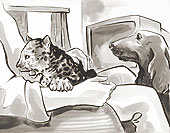 |
| Illustration by Suman Choudhury |
There came a point when none of Vasanth M. Shetty’s guests were interested in talking to him. This, too, at a time when the Bangalore-based veterinary doctor’s house was bursting with visitors.
Shetty’s new pet was hogging all the limelight. The coffee could come later; visitors wanted to meet the eight-month-old female leopard cub ? Chintu ? living in the doctor’s house. “Chintu attracts more people than us,” says Shetty, professor and head of department, surgery and radiology, Bangalore Veterinary College.
The National Geographic has come alive at the Shetty residence. As the lanky leopard strolls into the room, the first instinct is to back off. But Chintu knows how to put people at ease. She rolls on the floor, grunts playfully, pulls Shetty’s sleeve and gnaws his hand. She refuses to sit still, not even for photo-ops. “Chintu behaves like a domestic cat,” says Shetty.
Affection aside, leopards don’t belong in three-room government houses. Since Chintu couldn’t find a tree to climb in the house, she made do by jumping onto the fan. She didn’t know that a friendly slap causes a deep gash on human skin and that sofa upholstery is not meant for sharpening claws on.
Early this month, the leopard cub was sent back to the Banerghatta National Park (BNP), on the outskirts of Bangalore ? from where she came. “She will take less than a week to adjust to her new, wild habitat,” says Shetty.
Chintu was one of three cubs born to a leopard at the Banerghatta National Park. The mother rejected her cubs. She killed two and grievously injured Chintu. The week-old cub was rushed to the Bangalore Veterinary College with a gaping hole in her neck and skin ripped off her head. A three-hour-long emergency surgery was conducted to put her back in shape.
Post-surgery, the cub needed intensive care. This was not possible at the veterinary hospital, which shut shop by afternoon, says Shetty. “I offered to take the cub home,” he adds.
The Shetty family stood guard round the clock on the palm-sized cub for a fortnight. She had to be administered antibiotics and a few drops of milk every two hours. “She would lie lifeless. We didn’t know if she would live,” recalls Shetty.
Chintu pulled through. She slept less and began nosing around the house. She enjoyed eating her morning dosa. She made friends with a black street mongrel and even shared her dosa with him.
The cub sought affection and human contact. She refused to sleep in the out-house ? the room that was allotted to her. “She would howl till we got her back into the house,” says Shetty. Chintu liked to sleep on Shetty’s bed ? preferably on his pillow. She took her daytime snooze on the pet Irish Setter’s stomach.
But leopards don’t make permanent pets. When she was three months old, Shetty began training Chintu to live in her wild world. Raw meat replaced the dosa diet. Food affects temperament, says Shetty. She now growls while eating ? even Shetty is not allowed near her plate. “A raw meat diet makes an animal ferocious,” says Shetty.
Shetty’s Irish Setter liked to stay away from the leopard. Chintu’s games had become an ordeal for the dog. “A friendly back-slap from Chintu sent the dog reeling,” says Shetty. The two animals were tied at a safe distance from each other.
Chintu remained on a leash permanently. Shetty’s neighbours didn’t appreciate a half-grown leopard sauntering around the colony. “Our house help had warned she’d quit her job if we didn’t send the leopard away,” says Shetty.
A subconscious scare of wild animals surfaced. The last straw came when a group of people ? describing themselves as animal activists ? staged a protest outside Shetty’s house. “They demanded that I send the leopard back to where it belongs,” says Shetty.
Chintu was sent back to her wild roots. Shetty can hold his guests’ attention once again.











